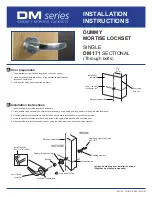
23
4.
Place the Dial Hub Locating
Gage over the spindle and
between the dial hub
assembly and the bushing
in the dial ring cover. This
sets up an initial 0.010 inch
end play.
5.
Push the dial hub and the
spindle assembly toward
each other. While maintain-
ing a constant pressure on
them, SECURELY tighten
the setscrews in the dial hub assembly to 17-20 inch-pounds of torque
(a minimum of 1 inch deflection of the handle of the hex key). Tighten
the inner setscrew first.
Caution:
Tighten in a downward motion in case the hex key should break.
6.
Remove the dial hub locating gage.
7.
Apply lubricant to the
retaining ring on the dial
hub assembly and posi-
tion the retaining ring so
that an equal amount of it
is consistently exposed
around the hub. Also,
apply grease from the
lubricant tube to the entire
ramp area just inside the
back of the dial and also
to the inner surface of the
5-sided formed clutch
spring within the dial.
Note:
Ensure that the retaining ring gap is aligned with the setscrews and
that an equal amount of the retaining ring is exposed around the hub
so the dial can slide easily into place on the hub without interference
from the retaining ring.
8.
Assure the the 5-sided flat spring is fully recessed in the dial with the
spring gap aligned with the internal key of the dial.
9.
Carefully align the dial assembly such that the 5-sided formed spring
matches the flats of the dial hub assembly. Holding the dial square to
the spindle, apply pressure to the dial until the retaining ring seats in
the dial.
Note:
You should not be able
to pull the dial away from
the dial hub assembly.
The dial clutch should
provide a slip torque of 7
to 25 inch pounds.
Tighten Setscrews
Place Gage Between Dial Hub &
Bushing
Setscrews
Retaining Ring Gap
Apply Lubricant Inside Dial
Apply Lubricant to Ret. Ring
5-Sided Flat Spring in Dial
Apply Pressure to Dial
Align Retaining Ring
Maintain Pressure on Spindle
Assembly









































